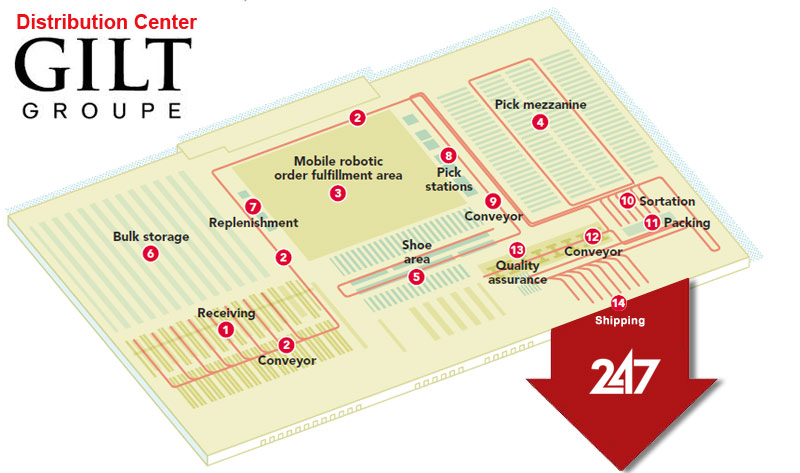Gilt’s New Distribution Center Delivers the Perfect Order
While speed is important, Gilt’s new distribution center system was also designed to deliver the perfect order, fast.
Receiving: The receiving process begins before product arrives at the Kentucky DC. When Gilt’s buyers make a purchase, the buy sheets are forwarded to a group of supply chain analysts who enter the vendor into Gilt’s enterprise software system. The information is provided to a Florida-based logistics provider that manages inbound logistics. The logistics provider, in turn, has created a feed into Gilt’s internal purchase order system. This allows the retailer to track the progress of orders.
Once a receiving schedule is created, the DC schedules a receiving team based on the volume of product that will be received and processed. Ninety percent of receipts are LTL shipments; the remainder is parcel shipments. Most merchandise is received as units rather than cartons or pallets.

In the receiving area (1), items are sorted and inspected to verify the merchandise and its condition. At that point, a bar code label is scanned to enter the merchandise into the warehouse management system (WMS).
The items are then put into a plastic tote by SKU. In clothing, this would typically be based on the size and color. Once the tote is full, the lid is closed and a bar code label on the tote is scanned to identify the storage area.
The items are now received and ready to be conveyed (2) to one of four storage areas.
Storage: Most newly received items will go on sale within a few days. Historically, once an item goes on sale, 80% of the total inventory is sold and shipped within 3 days. Using that rule, 80% of the product is stored in the mobile robotic picking solution (3). The remainder of the product will go into the pick mezzanine (4). In addition, a special area has been set aside to store and process shoes (5). Finally, the facility includes a limited amount of pallet rack for bulk storage (6). This area is reserved for non-conveyable products or seasonal products that may be received now but sold later.
Putaway into mobile robotic picking solution: Totes travel by conveyor (2) from the receiving area (1) to a replenishment area (7) for the robotic picking solution (3). When the tote arrives, an associate opens the tote and scans a bar code label on one of the items. That cues a mobile robot to deliver a storage carrier. The system will bring over enough pods to handle 80 plastic totes.
Putaway into picking mezzanine: The remaining totes bypass the mobile robotic replenishment area and are conveyed (2) to the pick mezzanine (4). If there are similar items already stored in a zone in the mezzanine, the tote will be sorted to that zone. When the tote arrives, an associate will scan the bar code label on the tote and direct it to the right putaway location. If there are no like items already in the mezzanine, the system will sort it to the zone with the most capacity. The operator can put the tote away in any available location. The storage location is confirmed by scanning the bar code label on the tote and the location bar code label.
Putaway in the shoe area: A special area has been set aside to store and process shoes (5). Similar to the mezzanine, product travels by conveyor to the area and is scanned into a storage location.
Putaway into bulk storage: In addition to clothing, Gilt also sells home décor and furnishings. Some of these items can’t be conveyed on the conveyor system. They will be delivered by lift truck to the bulk storage area (6) for putaway on pallet rack. This area is also reserved for seasonal items. For example, Gilt may sell a portion of an order of bathing suits in January. The remaining suits will go into storage for another sale in the spring or summer. In either case, the associate confirms the putaway by scanning a bar code label on the product and a location bar code label.
Picking: Flash sales are launched at noon ET. Shortly after that, orders begin to flow from the order management system into the WMS. Orders are prioritized around ship cut-off times. Next-day deliveries, for instance, may be filled first. DC management has visibility into the volume of orders. That allows management to staff the picking areas. The average order is 1.5 units. An order for four items could require an item from the shoe area (5), the mobile robotic picking solution (3), the pick mezzanine (4) and the bulk storage area (6). However, most orders are just one item picked from the mobile robotic solution.
Any order that includes shoes begins in the shoe processing area. Otherwise, the order fulfillment process begins when an operator signs into a pick station in the mobile robotic area (8). The operator begins with 12 empty totes. When the operator scans a bar code label on the tote, the robot will bring over a pod where an item for that order is stored. When the pod arrives, an overhead display will indicate which item should be picked. The associate places the item in the tote and confirms that the order is complete. The tote is then placed on an outbound conveyor (9) and the associate scans the next tote.
Once on the conveyor, the tote is automatically scanned. If the order requires more items, the tote is sorted to one of 24 zones in the pick mezzanine (4). Once it arrives, an associate will scan the tote and then be directed to the appropriate pick face.
Once all of the items for an order have been picked in the mobile robotic picking area or the picking mezzanine, the tote is placed back on the conveyor line (2). It is then sorted (10) to a packing area (11).
Packing and shipping: At a packing station, a packer removes a tote from the line and scans a bar code label. The packer then builds an appropriately-sized shipping container, prints and inserts the packing slip, confirms the accuracy of the order and then adds any packaging or dunnage. The shipping container is placed on the conveyor line (12) and transported to a quality assurance area (13) where the accuracy of the order is reconfirmed. At that point, the carton is weighed, taped and labeled for shipping and conveyed (12) for a fluid load (14) into a truck for delivery.
Be sure to read our article on Gilt Groupe’s Distribution Center: In-House Retail E-Commerce Order Fulfillment Distribution Center
Article Topics
ABCO Automation News & Resources
In-House Retail E-Commerce Order Fulfillment Distribution Center Gilt’s New Distribution Center Delivers the Perfect Order We Have To Go UpLatest in Transportation
Talking Supply Chain: Doomsday never arrives for Baltimore bridge collapse impacts Amazon Logistics’ Growth Shakes Up Shipping Industry in 2023 Nissan Channels Tesla With Its Latest Manufacturing Process Why are Diesel Prices Climbing Back Over $4 a Gallon? Luxury Car Brands in Limbo After Chinese Company Violates Labor Laws The Three Biggest Challenges Facing Shippers and Carriers in 2024 Supply Chain Stability Index: “Tremendous Improvement” in 2023 More TransportationAbout the Author













